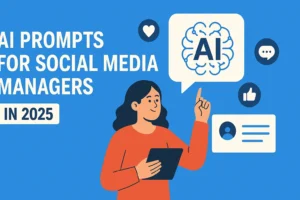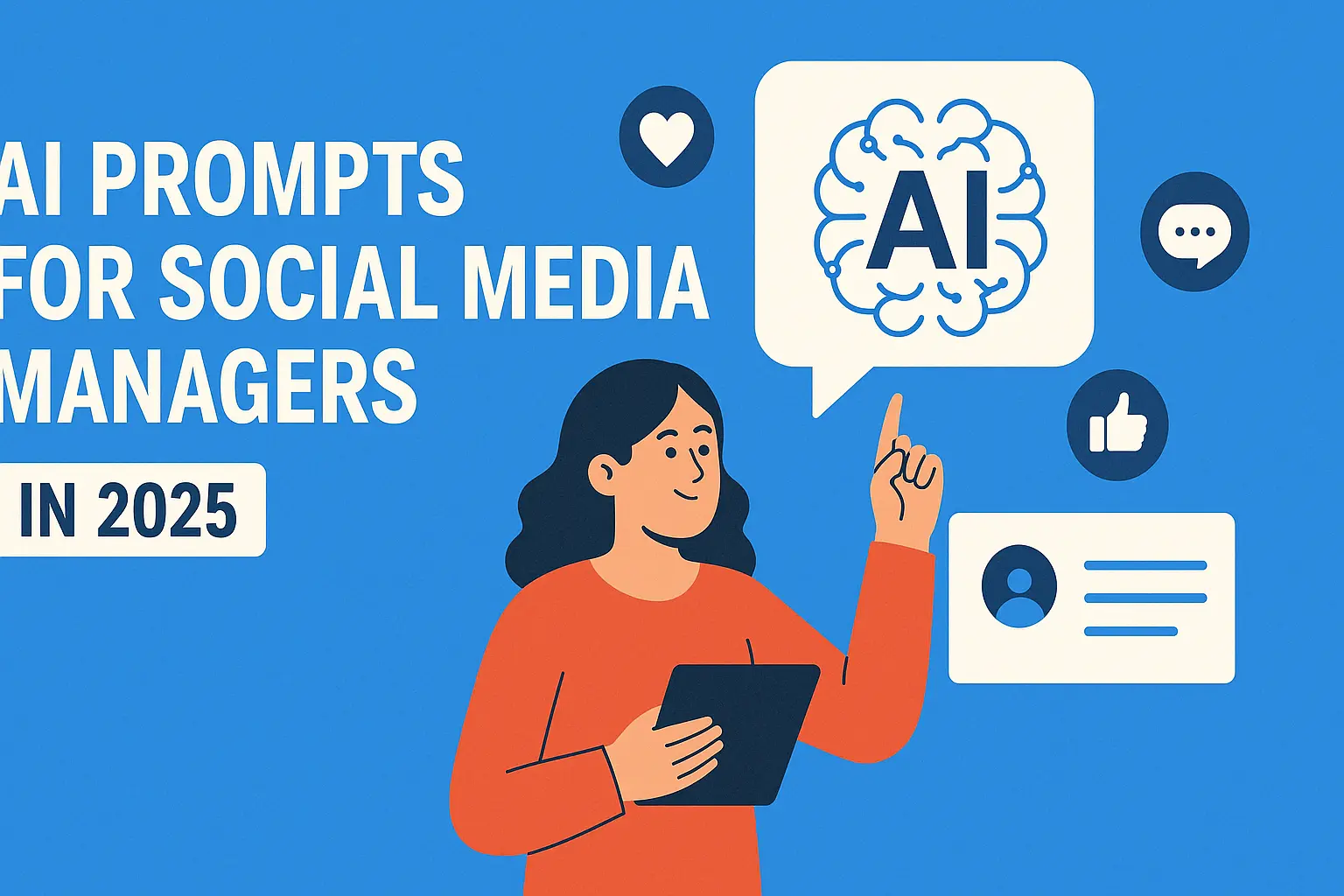Discover the power of AI prompts for social media managers in 2025. Learn how to leverage cutting-edge tools and best practices to enhance your social media strategy and drive engagement. Perfect for professionals looking to stay ahead in the digital marketing landscape.
Introduction
In the ever-evolving landscape of social media, staying ahead requires more than just creativity and strategy—it demands efficiency and precision. By 2025, Artificial Intelligence (AI) has become an indispensable ally for social media managers, offering tools that can automate, optimize, and enhance every aspect of social media management. At the heart of these AI tools are “AI prompts”—specific inputs designed to guide AI systems in generating desired outputs, from crafting compelling content to analyzing complex data sets.

This article delves into the world of AI prompts tailored for social media managers in 2025. We’ll explore what AI prompts are, how they function with various AI tools, and the different types that can revolutionize your social media strategy. Additionally, we’ll share best practices for creating effective prompts, provide real-world examples, and predict future trends in this exciting field. Whether you’re a seasoned professional or just starting out, understanding and leveraging AI prompts can significantly elevate your game, helping you connect with your audience more effectively and achieve your marketing goals with greater ease.
Understanding AI Prompts
What Are AI Prompts?
AI prompts are instructions or questions that users input into AI systems to receive specific outputs. In social media management, these prompts can generate content, analyze data, schedule posts, or manage community interactions. The effectiveness of an AI tool largely depends on the quality of the prompts provided, making them a critical skill for managers to master.
How AI Prompts Work with Different AI Tools
Different AI tools are designed for various aspects of social media management, each requiring tailored prompts. Here’s how they work:
- Content Generation Tools: Tools like Jasper and Copy.ai use prompts to create text for posts, captions, or blog articles. For example, a prompt might be: “Write a 100-word caption for an Instagram post about our new product launch, highlighting its key features and benefits.”
- Analytics and Reporting Tools: Platforms like Brandwatch or Sprout Social use prompts to generate insights. For instance: “Analyze the sentiment of mentions about our brand on X over the last week.”
- Scheduling and Automation Tools: Tools such as Buffer or Hootsuite support prompts for scheduling posts or automating responses. An example could be: “Schedule this post for optimal engagement time on Facebook.”
- Engagement and Community Management Tools: Tools like VistaSocial help manage audience interactions. A prompt might be: “Generate a response to a customer query about our shipping policy.”
Examples of AI Tools for Social Media Managers in 2025
Here are some leading AI tools for social media managers in 2025, based on recent industry insights:
| Tool Name | Best For | Standout Feature | Pricing |
|---|---|---|---|
| Sprout Social | Automation, analytics, insights | Comprehensive AI-driven management | Contact for pricing |
| Hootsuite | AI post prompt variety | Deep library of editable post templates | From $149/user/month |
| Buffer | Tailoring posts to each channel | Multichannel campaign management | Free plan; paid from $5/month/channel |
| FeedHive | Content recycling, conditional posting | AI Writing Assistant | From $15/month |
| Jasper | Content creation, performance analysis | 50+ templates, Chrome/Edge extension | Contact for pricing |
| Copy.ai | On-brand posts, captions, automation | Workflow automation | Contact for pricing |
| Brandwatch | Social media listening, campaign management | Sentiment analysis, trend tracking | Contact for pricing |
| Circleboom | AI-generated posts, flexible scheduling | AI post and tag generator | Contact for pricing |
These tools demonstrate the breadth of AI applications, each offering unique strengths to enhance social media strategies.
Types of AI Prompts for Social Media Managers
AI prompts can be categorized based on the tasks they help accomplish. Here are the primary types:
1. Content Generation Prompts
These prompts create text, images, or videos for social media posts. Examples include:
- “Generate an X post about our latest blog on sustainable fashion.”
- “Create a carousel post for Instagram showcasing our new collection.”
- “Write a LinkedIn post about our company’s recent partnership.”
Tools like Jasper, Copy.ai, and Publer excel in text-to-image generation and video creation.
2. Analytics and Reporting Prompts
These prompts extract insights from social media data. Examples include:
- “Show the top-performing posts from the last month on Instagram.”
- “Analyze the engagement rate of our Facebook posts by day of the week.”
- “Identify the most mentioned competitors in our industry on X.”
Brandwatch, Sprout Social, and Dash Social provide advanced analytics and listening features.
3. Scheduling and Automation Prompts
These prompts assist in planning and automating posting schedules. Examples include:
- “Schedule this post for next Wednesday at 10 AM on all platforms.”
- “Set up an automated response for common customer inquiries on Instagram.”
- “Create a content calendar for the next quarter based on our marketing goals.”
Buffer, Hootsuite, and FeedHive offer robust scheduling and automation features.
4. Engagement and Community Management Prompts
These prompts help interact with audiences and manage community relations. Examples include:
- “Generate a thank-you message for followers who commented on our recent post.”
- “Create a poll to gather feedback on our new product features.”
- “Draft a response to a negative comment on our Facebook page.”
Tools like VistaSocial and SocialBu assist in maintaining consistent tone and generating engaging captions.
By understanding these categories, social media managers can strategically use AI prompts to enhance workflows and achieve better results.
Best Practices for Creating Effective AI Prompts
Crafting effective AI prompts is crucial for maximizing tool performance. Here are key best practices:
1. Be Specific and Clear
Vague prompts lead to irrelevant outputs. Clearly state your needs. For example, instead of “Write a post about our product,” use “Write a 150-character X post highlighting the eco-friendly features of our new backpack.”
2. Provide Context
Include details like tone, audience, or platform specifics. For example: “Create a LinkedIn post about our company’s commitment to diversity, using a professional and inclusive tone.”
3. Use Keywords and Parameters
Incorporate keywords to guide the AI. For example: “Generate a fun Instagram caption for a back-to-school promotion, including hashtags #BackToSchool #StudentLife.”
4. Iterate and Refine
AI outputs may need tweaking. Refine prompts based on results. For instance, if a caption is too long, adjust the prompt to specify a character limit.
5. Stay Updated with Tool Capabilities
Each tool has unique strengths. Familiarize yourself with them to maximize potential. For example, use Jasper for long-form content and Copy.ai for quick captions.
Common Mistakes to Avoid
- Overloading with Information: Too much detail can confuse the AI. Keep prompts concise.
- Ignoring Platform Nuances: Tailor prompts to each platform’s style and audience.
- Not Testing: Test prompts with small samples to ensure they work as expected.
Tailoring Prompts to Specific Social Media Platforms
- X: Short, punchy, often includes hashtags or mentions.
- Instagram: Visual-focused, prompts may include image descriptions or carousel setups.
- LinkedIn: Professional tone, longer posts, industry-specific jargon.
- Facebook: Casual, community-oriented, includes event promotions or group interactions.
Following these practices ensures prompts yield high-quality, relevant content, driving better social media performance.
Case Studies and Examples
Here are hypothetical scenarios showcasing effective AI prompt use in 2025:
Case Study 1: Content Generation with Jasper
A fashion brand aimed to boost Instagram engagement. Using Jasper, they prompted: “Create a captivating caption for our new summer dress collection, emphasizing comfort and style.” The resulting captions resonated with their audience, leading to a 25% increase in likes and comments.
Case Study 2: Analytics with Brandwatch
An e-commerce company wanted to understand sentiment about their new “EcoTech” product line. They used Brandwatch with the prompt: “Analyze mentions of our ‘EcoTech’ series on X and Instagram for the past month, focusing on sentiment and key themes.” Insights revealed pricing concerns, enabling a strategic marketing adjustment.
Case Study 3: Scheduling with Buffer
A tech startup needed a consistent posting schedule without overburdening their team. Using Buffer, they prompted: “Schedule this announcement post for when our audience is most active on LinkedIn.” This ensured maximum visibility, resulting in a 30% increase in post reach.
Case Study 4: Engagement with VistaSocial
A lifestyle blog struggled with timely comment responses. Using VistaSocial, they set prompts like: “Thank you for your question about our travel tips! We’ll post more details soon.” This automation maintained engagement, improving follower retention.
These examples highlight how AI prompts, paired with the right tools, can enhance social media management.
Future Trends in AI Prompts for Social Media
As AI evolves, several trends will shape AI prompts for social media management:
1. Increased Personalization
AI tools will tailor content to specific audience segments. Example: “Generate a post for our millennial audience in New York City.”
2. Integration of Multimodal Prompts
Prompts will include images, videos, or voice commands. Example: “Create a video script based on this image of our new product.”
3. Predictive Analytics in Prompt Design
AI will suggest prompts based on predictive analytics. Example: “Based on trends, create a post about sustainability this week.”
4. Enhanced Natural Language Processing
Improved NLP will enable nuanced, context-aware prompts. Example: “Write a post matching the tone of our last five successful posts.”
5. Cross-Platform Optimization
Prompts will optimize content across multiple platforms. Example: “Create a post adaptable for X, Instagram, and LinkedIn with minimal changes.”
6. Ethical AI and Bias Reduction
Prompts will promote ethical AI use, reducing biases. Tools may include inclusivity checks for generated content.
Staying ahead of these trends will help social media managers leverage AI prompts effectively in a competitive digital landscape.
Conclusion
AI prompts are a game-changer for social media managers in 2025, streamlining workflows, boosting creativity, and driving engagement. By understanding prompt types, mastering best practices, and exploring tools like Sprout Social, Hootsuite, and Jasper, managers can unlock AI’s full potential. As future trends like personalization and multimodal prompts emerge, the possibilities will only grow.
Experiment with the tools and prompts discussed here and share your experiences in the comments below. Which AI prompt worked best for you? How has AI transformed your social media management? Let’s continue the conversation and learn from each other in this exciting era of digital marketing.
Call-to-Action: Ready to elevate your social media game? Try one of the AI tools mentioned and see how AI prompts can transform your content creation and management. Share your success stories with our community to inspire others!

1 thought on “Best AI Prompts for Social Media Managers in 2025”